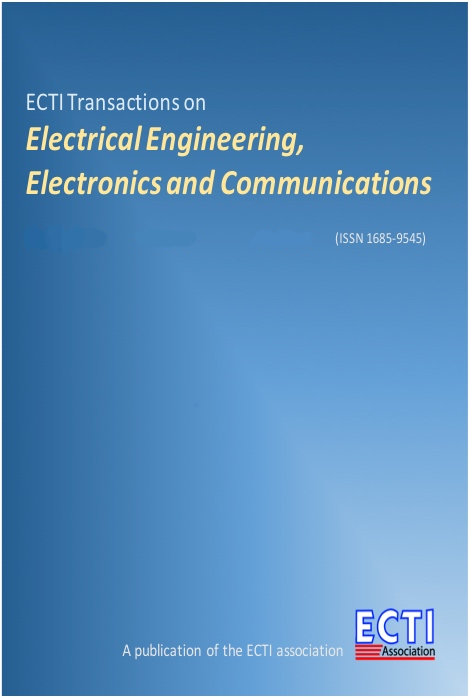Control of mobile robot using fractional order PI<sup>λ</sup>D<sup>μ</sup> controller
Main Article Content
Abstract
The ideal example for studying complex systems with non-holonomic constraints is mobile-wheeled robots. In this article, we study the problem of trajectory tracking of mobile robot unicycle type. To resolve this type of problem a fractional-order control technique is proposed. The main objective of this control method is to design a robust tracking controller to eliminate disturbances. The mathematical model of the mobile robot taken explicitly into account their dynamics is used to calculate the desired linear and angular velocities. To adjust the controller optimal parameters the particle swarm optimization (PSO) algorithm is utilized. The simulation results allowed us to demonstrate the efficiency and robustness of this technique on non-holonomic systems in the form of chained chains.
Article Details
This journal provides immediate open access to its content on the principle that making research freely available to the public supports a greater global exchange of knowledge.
- Creative Commons Copyright License
The journal allows readers to download and share all published articles as long as they properly cite such articles; however, they cannot change them or use them commercially. This is classified as CC BY-NC-ND for the creative commons license.
- Retention of Copyright and Publishing Rights
The journal allows the authors of the published articles to hold copyrights and publishing rights without restrictions.
References
[2] R. Fierro, F. L. Lewis,” Control of a nonholonomic mobile robot: backstepping kinematics into dynamics, in Decision and Control” Proceedings of the 34th IEEE Conference, vol. 4, pp. 3805–3810, 1995.
[3] G. Yanfeng, Z. Hua. “Back-stepping and neural network control of a mobile robot for curved weld seam tracking”, Procedia Engineering, vol. 15, pp.38–44, 2011.
[4] M.Z. Ab Rashid, S.N. Sidek. “Controller Design of Unicycle Mobile Robot”. Iium Engineering Journal, vol.3, No 2, pp. 173-192, 2012.
[5] Qing Xu, Jiangming Kan. “Fuzzy PID based trajectory tracking control of mobile robot and its simulation in Simulink”. International journal of control and automation. vol.17, No 8, pp.233-244, 2014.
[6] T. Das, I. N. Kar, “Design and implementation of an adaptive fuzzy logic-based controller for wheeled mobile robots”. Control Systems Technology, IEEE Transactions on. vol. 14 No 3, pp. 501–510, 2006.
[7] Y. Cai, Q. Zhan, “Path tracking control of a spherical mobile robot. Mechanism and Machine Theory vol. 51, pp. 58–73, 2012.
[8] G. Guoqin, R. Yi. “Smooth sliding mode control for trajectory tracking of greenhouse spraying mobile robot”. telkomnika Indonesian Journal of Electrical Engineering, vol. 11 No 2, pp. 642–652, 2013.
[9] L. Gracia, F. Garelli. “Integrated sliding-mode algorithms in robot tracking applications”. Robotics and Computer-Integrated Manufacturing, vol. 29, No 1, pp.53–62, 2013.
[10] Bessas Aicha, Atallah Benalia and F. Boudjema. “Trajectory Tracking of a Unicycle-Type Mobile Robot Using Second-Order Sliding Mode Control”. International Conference on Electrical Engineering and Automatic Control, Algeria, 2013
[11] M. Ashoorirad, R. Barzamini. “Model reference adaptive path following for wheeled mobile robots”. Information and Automation ICIA. International Conference on. IEEE, pp. 289–294, 2006.
[12] E. Canigur, M. Ozkan. “Model reference adaptive control of a nonholonomic wheeled mobile robot for trajectory tracking”. Innovations in Intelligent Systems and Applications (INISTA), International Symposium. IEEE, pp.1–5, 2012.
[13] F. N. Martins, W. C. Celeste. “An adaptive dynamic controller for autonomous mobile robot trajectory tracking”. Control Engineering Practice, vol. 16, No 11, pp.1354–1363, 2008.
[14] J. Taheri-Kalani and M. Khosrowjerdi, “Adaptive trajectory tracking control of wheeled mobile robots with disturbance observer,” International Journal of Adaptive Control and Signal Processing, vol. 28, No 1, pp. 14–27, 2014.
[15] G. Scaglia, A. Rosales, “A linear-interpolation-based controller design for trajectory tracking of mobile robots,” Control Engineering Practice, vol. 18, No 3, pp. 318–329, 2010.
[16] Zaharuddin Mohamed, Ariffanan Basri, “Velocity control of a unicycle type of mobile robot using optimal pid controller”. Journal teknologie(sciences and Engineering), vol. 78, pp. 7–14, 2016
[17] Mouwafak A. Tawfik,Emad N. Abdulwahb, Salah M. Swadi “Trajectory Tracking Control for a Wheeled Mobile Robot Using Fractional Order Controller” Al-Khwarizmi Engineering Journal, Vol. 10, No 3, pp. 39- 52, 2014.
[18] A. Oustaloup, “La dérivation non entière,” Hermes, 1995.
[19] W. Hui-fang, H. Qiu-sheng, Z. Zhi-cheng and Z. Jing-gang, “A design method of fractional order PIλDμ controller for higher order systems” Proceeding of the 34th Chinese Control Conferencepp. 272-277, 2015,
[20] A. Tepljakov, E. Petlenkov and J. Belikov, “FOMCON: Fractional-order modeling and control toolbox for MATLAB,” Proceeding 18th Int Mixed Design of Integrated Circuits and Systems (MIXDES) Conference, pp. 684-689, 2011.
[21] C. De La Cruz and R. Carelli, “Dynamic modeling and centralized formation control of mobile robots,” in IEEE Industrial Electronics, IECON, 2006, pp. 3880–3885
[22] F. Padula nad A. Visioli, “Set-point weight tuning rules for fractionalorder PID controllers,” Asian Journal of Control, vol. 15, No 3, pp. 678-690, 2013.
[23] Xue, D and al. "Linear Feedback Control Analysis and Design wih MATLAB", USA: The soceity for Industrial and Applied Mathematics. 2007
[24] Jun-Yi Cao and Bing-Gang Cao “Design of Fractional Order Controller Based on Particle Swarm Optimization” International Journal of Control, Automation, and Systems, vol. 4, No 6, 2006, pp. 775-781.


